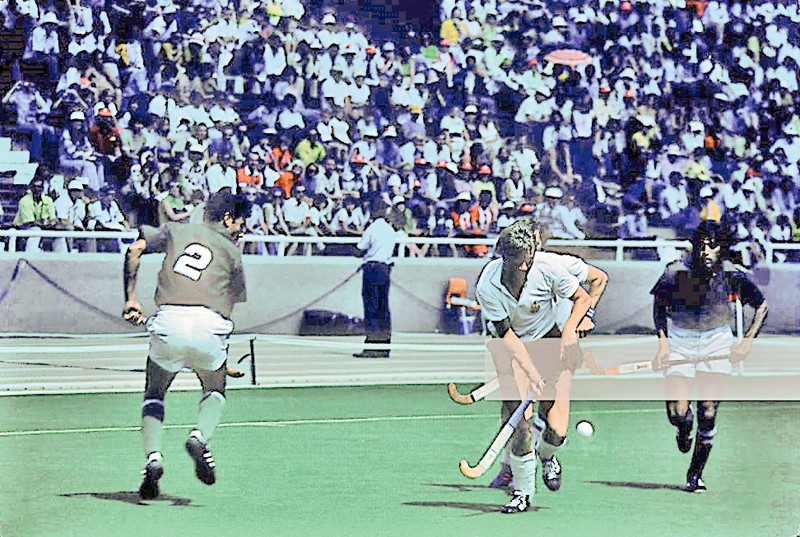

For the last 30 years or so, grass has virtually been rooted out of international hockey. The International Hockey Federation (FIH) does not approve any international tournament on a grassy surface.
Sometimes exceptions are made, however. In late ‘90s, a regional international tournament in Greece was organised in which there were teams of Croatia, Albania among others.
The tournament was mainly meant for introducing the game in these countries as till then very little hockey was played there.
As the host country lacked any artificial surface, the FIH gave special permission for the tournament to be played on grass. All this seems unbelievable, taking into account the fact that there was no such thing as astro-turf in hockey till about 40 years ago.
The first-ever international hockey tournament on a synthetic turf was the pre-Olympic tournament in 1975 in Montreal, Canada. 2016 is an Olympic year, and it was 40 years back at the 1976 Olympics, also at Montreal, that the first mega hockey event was staged on astro turf.
Pakistan were among the top contenders in those golden days. It was a highly gifted side. The forward line of Islahuddin, Manzoor Jr, Abdul Rasheed Jr, Shahnaz and Samiullah could be compared favourably with any front quintet in history.
Hanif Khan, a pint-sized rookie forward and star of the future, was among the reserves.
In addition, they had that great centre half Akhtar Rasool and perhaps the finest pair of full-backs in Manzoorul Hassan and Munawwar-uz-Zaman.
The goalkeepers were the legendary Saleem Sherwani and the dependable Qamar Zia. Only the two wing halves, Saleem Nazim and Iftekhar, could be deemed as not of the highest class.
Pakistan easily topped the pool, winning three of their four matches, including a 4-2 victory over the defending Olympic champions West Germany.
They did get a scare in the outing against Spain. It took a penalty corner conversion by Munawwar five minutes from the end for Pakistan to level 2-2 against the European Champions.
Pakistan were the favourites for the semi-final against Australia. They were off to a dream start. The very first minute saw Akhtar Rasool putting them ahead via a penalty stroke. Five minutes later, ace forward Shahnaz Sheikh had to leave the field after being struck by the stick of the Aussie spearhead Riley. In a move debated till today, manager M H Atif sent in Mudassar as Shahnaz’s replacement. Mudassar could only play as right-in. Haneef Khan, an original left-in, would have been a better choice in most people’s opinion. Mudassar’s entry also meant that right-in Manzoor Jr was shifted to the left-in spot. This shuffling had a marked effect on the forward line. Three minutes from the interval, Riley, standing unmarked, scooped the ball into the cage after a back pass from the Australian hockey legend Ric Chalesworth.
Midway into the second half, Haneef was eventually brought in to replace the ineffectual Mudassar but it was too late.
In the 59th minute, Jim Irvine converted a penalty corner to take Australia into the final.
In the bronze medal play-off, Pakistan managed to overcome the Netherlands 3-2 in an exciting encounter.
Pakistan’s sorrows were deepened to see Australia beaten in the final by none other than New Zealand whom the Green-shirts had trounced 5-2 in the pool game.
It may be pointed out that till 1984, grass and astro turfs, sort of, took turns in staging the World Cup and Olympic events. The World Cups of 1978 and 1982 were played on grass and the Olympics of 1980 and 1984 were staged on astro turfs.
Since 1984, though, all the international tournaments have been held on synthetic turfs.
What was the need for introducing astro-turf? Some opine that it was done to favour the non-Asian hockey nations. Till then, Pakistan and India had been winning almost all the Olympics and the World Cups.
But objective analysis suggests something else. In football, lifting the ball off the ground is common not only for long overhead balls, but also for short passes. In case of hockey about 80 percent of the time the ball travels along the surface.
So, for a good display of hockey skills of ball control, dribbling and passing, a pitch as close to the billiards table in terms of smoothness of surface is essential.
But then there have been masters in preparing perfect grassy hockey grounds having the aforementioned quality. Still there was a reason for having synthetic turfs: to counter Mother Nature.
Many a time, excellent hockey grounds turned into pools of water due to sudden rains rendering the true display of hockey impossible. Synthetic turfs tackle this problem as they are designed to absorb water. Paradoxically, it favours the Indians and the Pakistanis.
The players from the sub-continent being less exposed to rainy conditions at home had to suffer more in such circumstances.
In Pakistan’s very first international outing, the 1948 Olympics, they faced the hosts Britain in the semi-final. Having won all their four pool matches comfortably, Pakistan, who were the favourites, went down to Britain. Many old stalwarts attributed it to a heavy downpour in London that particular morning. They said the British players were not affected much being accustomed to such conditions.
In 1979, Pakistan won the high-profile Esanda Cup tournament in Australia on astro turf when there was no such facility in the country. There was only one astro turf at home when Pakistan won the gold medal at the 1984 Olympics.
It is only some hockey officials in these two countries who put the blame on the astro turf to hide their shortcomings.
Pakistan won the 1982 World Cup on grass turfs and the 1984 Olympics on astro turfs. Hasan Sardar and Hanif Khan, two of the greatest forwards, starred in both the events. Who could be a better judge than them? Both say that astro turf is more conducive to our style of play, based on stick work, short passes and dribbling.
The debate must end here.